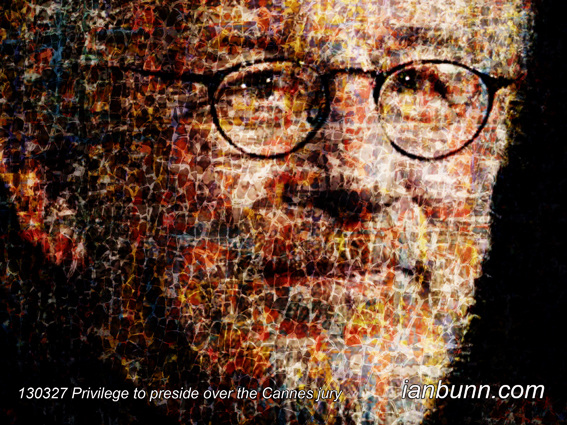 Its referents become distant with time (April 16 2013)
Its referents become distant with time (April 16 2013)
Jason Lazarus the 37 year old American artist, curator, writer, and Assistant Adjunct Professor has been interviewed by Julia Halperin for Blouin Artinfo in an article titled ‘26 Questions for Semiotically Inclined Photo and OWS Sign Artist’. In the article Lazarus states “The documentation of OWS created more questions than answers — the disparate messages on protest signs resisted clear, linear, or congealing narratives that traditional media rely on to produce content. Re-creating the signs, collaboratively, with the public, allowed a way to not only produce those messages documented widely across time and space en masse, but the process of creating them literally slowed down readings of the phenomenon, producing an experience of heightened awareness of the productive (unresolved) questions that linger in OWS’s wake as well as to the economy of protest (materials, aesthetics, scale, textual play/innuendo/multiple layers of meaning). The project is a kind of reverse-photography, imaging 3D sculptures from flattened images demands a careful, multiple-layered, and active reading. …The project … frames a collective process of becoming where our strain of late capitalism is openly and visibly questioned and criticized as incompatible with our current iteration of democracy. Meanwhile, the capital in the system, like water, continues to fill in the gaps with unending resilience and infinite flexibility. … it’s important to me that the project started as re-created signs that actually occupied public space as part of Occupy USF Tampa, and they have since traveled to alternative exhibition spaces on their way to a museum. They will make their way back to alternative venues and street as well. Political art is optimal when it’s most liquid, able to travel through contexts and paradigms. I’m interested in how this project will change as its referents become distant with time.”
Inspired by Julia Halperin, Blouin Artinfo ow.ly/jAq2p Image source Twitter ow.ly/jAq0S











![David Choe the 36 year old American painter, muralist, graffiti artist and graphic novelist of Korean descent, having achieved success with his "dirty style" figure paintings comprising raw, frenetic works which combine themes of desire, degradation, and exaltation; has been the subject of an article on The Daily Beast by Lizzie Crocker titled ‘Facebook Artist David Choe Launches New Gig With Porn Star Asa Akira’. Crocker states “A year after David Choe became the most surprising multimillionaire to emerge from Facebook’s IPO, the bad-boy graffiti artist is making the publicity rounds with a new pornographic podcast featuring porn star Asa Akira. ...Tits, ass, and goblins. Bare-chested chicks straddling hellhounds. Perverse imagery has long permeated graffiti artist David Choe’s work, including the infamous murals he spray-painted at Facebook’s first headquarters in Palo Alto, Calif. The company’s then president, Sean Parker, allegedly told Choe to “go crazy and draw as many giant ‘cocks’” on the walls as he wanted. Choe was paid for the job in Facebook stock, which was valued at $200 million when the social media behemoth went public last February. …A year later, Choe is opening up about his new gig with porn star Asa Akira: DVDASA … The first two episodes of DVDASA feature comedian Yoshi Obayashi as a special guest, though Choe hopes to lure actors, rap artists, and other “legitimate people” into the podcast studio… He claims he created the podcast as a forum to voice personal transgressions and divulge bizarre fetishes and fantasies. “When you talk about everything openly, it’s hell on your personal relationships,” he says. “It’s weird, because it feels good and yet it’s also really self-destructive. But [Asa and I] have already figured out that we’re self-destructive people anyway, so it’s like, fuck it.” Inspired by Lizzie Crocker, The Daily Beast ow.ly/hYBSx Image source Facebook ow.ly/hYBS8](http://www.ianbunn.com/wp-content/uploads/2013/03/130309dcU60.jpg)


![Llyn Foulkes the 78 year old American artist creating landscape paintings that utilized the iconography of postcards, vintage landscape photography, and Route 66-inspired hazard signs, returning to his childhood interest in one-man bands and began playing solo with "The Machine," which he created. Foulkes has been interviewed by Scott Indrisek in an article published in Blouin Artinfo titled ‘Renegade Llyn Foulkes is Making a Comeback With a Major Survey at the Hammer’. Indrisek states “…Foulkes is having his second big moment. The L.A. artist and musician showed with Ferus Gallery in the 1960s and enjoyed early recognition for quirky, detailed oil paintings — an enormous cow, or rocks that sort of looked like people. He later moved on to more complicated mixed-media works, creating intricate scenes that brought together cartoon culture and self-portraiture as well as an ongoing series of grotesque bloody heads. …Foulkes had had a few recent pieces in last year’s Documenta (13) exhibition, where he also sang and performed with his complicated, self-made musical instrument, dubbed the Machine. [in the interview Foulkes states] “…Early on in the ’60s I was pretty well known, and then I gave up what I was doing and tried to go back to what I was doing before. Art changed, Minimalism and installation art and all that stuff came in, and there wasn’t that much in the art magazines about me in the ’80s. I’ve had problems from the stock market of art — let’s put it that way. I’ve always been out of the mainstream because I always talk against what’s going on in art. …I’ve always been pretty much a loner, in the sense that I didn’t really associate with that many other artists...” Inspired by Scott Indrisek, Blouin Artinfo ow.ly/hMxcu Image source Facebook ow.ly/hMxca](http://www.ianbunn.com/wp-content/uploads/2013/02/130228dcU60.jpg)


![Hillary Diane Rodham Clinton the 65 year old American politician, wife of the 42nd President of the United States Bill Clinton, leading candidate for the Democratic 2008 presidential nomination, and the US Secretary of State, has been the focus of an article by David Rohde on Reuters titled ‘Clinton: International portfolio, domestic concerns’ referring to her potential candidacy for the 2016 presidential nomination. Rohde states “…She [Clinton] has been a very good but very cautious secretary of state, who kept her distance from Afghanistan and other seemingly intractable conflicts. Clinton established a strong relationship with President Barack Obama, was innovative and worked tirelessly, but her position as a potential 2016 presidential candidate clearly influenced her performance. One State Department official praised Clinton’s tenure, but talked about looking forward to the arrival of her presumed successor, Senator John Kerry. …After promising a sweeping break with the approaches of President George W. Bush, the Obama White House has proved just as insular and controlling of foreign policy as the Bush administration. …Obama’s first-term foreign policy was marked by cautious, political calculation. Members of his foreign policy team rightly point to the president’s re-election as proof that their approach worked. A more decisive Obama approach in foreign affairs, though, may have helped him at the ballot box. …The lesson of Iraq is that American invasions are not the answer. But neither is isolation. Traditional American diplomatic engagement is needed in the Middle East, including efforts to resolve the Israeli-Palestinian conflict. At the same time, new means of diplomacy – what Clinton called “smart power” – should be carried out as well. U.S. trade, technology and private investment – not simply drones – should be used to counter militancy. Clinton deserves credit for restructuring the State Department and embracing innovative new forms of diplomacy.” Inspired by David Rohde, Reuters ow.ly/hhRPd Image source Kai Mork ow.ly/hhRIm](http://www.ianbunn.com/wp-content/uploads/2013/02/130209dcU60.jpg)






![Elisabeth Rosenthal the American medical doctor specializing in epidemic disease, scientific and environmental matters has published an article in the New York Times titled ‘As Biofuel Demand Grows, So Do Guatemala’s Hunger Pangs’. Rosenthal states “In the tiny tortillerias of this city [Guatemala City], people complain ceaselessly about the high price of corn. Just three years ago, one quetzal — about 15 cents — bought eight tortillas; today it buys only four. And eggs have tripled in price because chickens eat corn feed. …Recent laws in the United States and Europe that mandate the increasing use of biofuel in cars have had far-flung ripple effects, economists say, as land once devoted to growing food for humans is now sometimes more profitably used for churning out vehicle fuel. In a globalized world, the expansion of the biofuels industry has contributed to spikes in food prices and a shortage of land for food-based agriculture in poor corners of Asia, Africa and Latin America because the raw material is grown wherever it is cheapest. …With its corn-based diet and proximity to the United States, Central America has long been vulnerable to economic riptides related to the United States’ corn policy. Now that the United States is using 40 percent of its crop to make biofuel, it is not surprising that tortilla prices have doubled in Guatemala, which imports nearly half of its corn. At the same time, Guatemala’s lush land, owned by a handful of families, has proved ideal for producing raw materials for biofuels. Suchitepéquez Province, a major corn-producing region five years ago, is now carpeted with sugar cane and African palm. …Roughly 50 percent of the nation’s children are chronically malnourished, the fourth-highest rate in the world, according to the United Nations.” Inspired by Elisabeth Rosenthal, New York Times ow.ly/gKkg3 Image source Twitter ow.ly/gKkeF](http://www.ianbunn.com/wp-content/uploads/2013/01/130117dcU60.jpg)


![Robert Barry the 76 year old American artist renowned for his non-material works of art, installations, and performances using a variety of otherwise invisible media, has been interviewed by Celine Piettre for Blouin Artinfo in an article titled ‘Artist Robert Barry Discusses Working With "Time, Light, and Darkness"’. Barry states “I don’t like this term [Conceptual Artist]. I find it very limiting, as far as I’m concerned in any case. I use materials: time, space, color, words. My work is visual, and not purely about ideas or concepts. …I don’t work so much on language as on words, which I perceive as objects. They have a color, a size. They exist in a given space and time. They have a tangible aspect. Words are also very personal. They come from us and say things about us. They have a story. We all interpret them according to our own experience. I’m always surprised when people ask me this question. I’m interested in words — that’s it. It’s like I painted flowers or landscapes. It’s a personal interest, a work material that offers infinite possibilities. …Video is a natural medium for me. I’ve used it since the beginning of my career. It’s a medium of time — a notion, a material that is truly integral to my work, like light. I like the idea of light emerging from the darkness and plunging into it again. It’s something that everyone experiences. …It’s important to me that there can be different levels of perception, experiences, and time. All these components of the real are combined here: the idea of art, war, light, words, and speech — they work together to make the piece. … In general, I like using music in my work because it’s an art that exists in time.” Inspired by Celine Piettre ow.ly/gwWNu image source TownNews ow.ly/gwWMO](http://www.ianbunn.com/wp-content/uploads/2013/01/130113dcU60.jpg)

